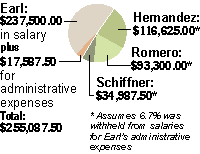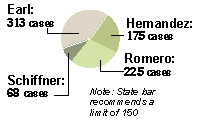 |
 |
 |
|
|
Monday, April 5, 2004 Although paid with public funds, Tom Earl's income as administrator of a public-defense contract was not public record. But with information drawn from interviews and letters, it can be approached like a math problem. Grant County paid Earl $500,000 a year to handle all indigent cases in Superior Court. From that, he paid subcontracting attorneys, overhead and administrative costs. The subcontractors typically handled a set percentage of the cases for a fixed fee. Knowing their pay helps determine Earl's take. In 2002, he employed three subcontractors; each disclosed his pay to The Seattle Times: • Ben Hernandez said he took 25 percent of the cases for $125,000. • Guillermo Romero said he took 20 percent of the cases for $100,000. • Robert Schiffner said he took 7.5 percent of the cases for $37,500.
But Earl withheld a percentage of each subcontractor's pay for such expenses as investigators, expert witnesses and his time spent administering the contract. Figures provided by Romero and Schiffner put that deduction at 6.7 percent. So, $262,500 x .067 (6.7 percent) = $17,587.50 that Earl held back for administrative expenses. Add $17,587.50 to $237,500 and you get $255,087.50. That's what Earl would pay himself, minus overhead and administrative costs. As contract administrator, Earl decided which cases went to which subcontractors. Using that power of assignment, he reduced his workload.
In 2002, Earl actually handled 40 percent of the cases, not 47.5 percent, according to figures he provided the county. Romero wound up with 29 percent of the cases, not 20.
Bar groups urge a limit of 150, saying overwhelming caseloads diminish an attorney's effectiveness. Grant County had 781 indigent felony cases in 2002, according to Earl's figures. With $500,000, Earl could have distributed the money and cases in a way that met caseload standards: He could have hired five attorneys, at $75,000 each, to handle 130 cases each. (In King County, a public defender who makes $75,000 is doing well.) That would have left Earl with $125,000 — and with 131 cases. — Ken Armstrong, Seattle Times staff reporter
|
|
||||||||||||||||
seattletimes.com home
Home delivery
| Contact us
| Search archive
| Site map
| Low-graphic
NWclassifieds
| NWsource
| Advertising info
| The Seattle Times Company

